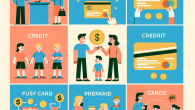
Should You Buy Crypto as a Beginner? My Unfiltered First Attempt
How to Budget When You’re Broke: A Beginner’s Guide to Taking Control
Look, I’ve been there. Ramen in the pantry, half a tank of gas, and $27.83 in the bank—and rent’s due in five days. If you’re starting your financial journey from the ground floor (or what feels like the basement), I get it. Budgeting might sound like something you’ll worry about “once you have enough money to budget,” but let me stop you right there. The time to start is now.
This guide is for financial first-timers, paycheck-to-paycheck warriors, or anyone who’s ever asked themselves, “How am I supposed to budget when I barely have any money?” Good question—and one we’re going to answer, step by step, with zero fluff and a whole lot of real talk.
Why Budgeting Matters Even When You’re Broke
When money’s tight, budgeting becomes even more essential. It’s not about cutting out every fun thing in your life, and it definitely isn’t about shame—it’s about clarity. Budgeting gives you control. You can stop living in mystery and start making decisions consciously. It’s the first step toward any financial goal, whether that’s building a $1,000 emergency fund or just making it to next Friday without overdrafting.
What Budgeting Actually Means
A lot of folks think “budgeting” equals “restriction.” But really, budgeting is just a plan—a roadmap for how you’ll use the money you already have. Just like GPS helps you avoid traffic and closed roads, a budget helps you avoid financial detours (like surprise overdraft fees or the dreaded “Insufficient Funds” notification at the grocery checkout).
Step 1: Know Exactly How Much You’re Working With
Not what you should be making. Not what you want to make. What you actually take home after taxes. We’re talking your real income.
Start with your monthly or bi-weekly take-home pay. If your income is irregular (shoutout to my fellow freelancers and gig workers), look at a three-month average. This is your budget’s starting line.
Track Every Dollar Coming In
Write it all down in a notebook, a spreadsheet, or a budget app. Doesn’t matter how you do it—just make it real. Use your bank statements if you’re not sure. You can’t control what you don’t measure.
Step 2: List All Monthly Expenses
Here’s where you face the music. Grab your bank statements, credit card bills, receipts—whatever tells the story of how you spend money. Divide your expenses into two categories:
1. Fixed Expenses
- Rent or mortgage
- Utilities
- Phone and internet
- Insurance (car, health, etc.)
2. Variable Expenses
- Groceries
- Transportation (gas, Uber, public transit)
- Entertainment
- Dining out
- Subscriptions (streaming, apps, etc.)
Heads-up: You’ll probably feel a blend of surprise, regret, and confusion during this stage. That’s normal. You’re not bad with money—you just haven’t learned the game yet. Until now.
Step 3: Prioritize Like a Pro
When you’re living paycheck to paycheck or with fluctuating income, prioritizing becomes essential. Use this simple system I call the “Four Walls” of survival budgeting:
- Food – You need to eat to think. Period.
- Housing – Keep the lights on and the roof over your head.
- Transportation – You can’t earn if you can’t get to work.
- Utilities – Heat, water, and internet aren’t optional.
If your income only covers the Four Walls for now, start there. Anything extra goes to catching up on bills, eliminating high-interest debt, or—if you’re ready—starting an emergency fund.
Step 4: Build a Zero-Based Budget
A zero-based budget means every dollar has a job. Income minus expenses should equal zero—because you’ve assigned every bit of income to a specific purpose, whether that’s rent, food, debt payoff, or savings. Here’s a simple breakdown:
- Income: $1,500
- Rent: $600
- Groceries: $250
- Utilities: $120
- Gas/Transport: $80
- Minimum debt payment: $100
- Phone bill: $50
- Savings: $100
- Total: $1,500
You don’t need fancy tools—just discipline and honest math. Apps like YNAB or EveryDollar make it easier if you prefer tech support, but pencil and paper still get the job done.
Step 5: Cut Costs Without Cutting Joy
We’re not out here trying to live a joyless spreadsheet existence, but when you’re broke, every dollar counts. Luckily, you can reduce expenses with a little creativity:
Tips to Spend Less Without Feeling Miserable
- Cancel unused subscriptions (be honest—do you really need 5 streaming services?).
- Cook at home—it’s cheaper and healthier.
- Call service providers and ask for lower rates (phone, internet, insurance—you’d be surprised).
- Use your local library—for books, movies, workshops, and even internet access.
- Swap clothes, tools, or household goods with friends or neighbors.
Remember: Cutting back today doesn’t mean sacrificing forever. This is a temporary step toward long-term freedom.
Step 6: Start an Emergency Fund (Yes, Even with $5)
It might sound ridiculous to save when you’re broke, but this is where financial resilience begins. An emergency fund is your buffer against chaos—lost income, car trouble, surprise medical bill. Start small. Five bucks a week adds up.
Use a high-yield savings account, and automate what you can. Even if it’s just the cost of one fancy coffee, it’s a start. Once you’ve reached $500, aim for $1,000. It’s your financial airbag.
Your Mindset is Your Secret Weapon
If there’s one thing I need you to walk away with, it’s this: You’re not bad with money, you’ve just never been taught. Budgeting while broke isn’t about shame—it’s about empowerment. It’s the first brick in your financial foundation, and every choice from here is a step toward independence.
Final Thoughts
Starting a budget when you’re broke might feel overwhelming, but it’s one of the most powerful acts of personal agency you can take. Don’t wait for your income to grow or your bills to shrink. Just start—where you are, with what you have.
Eventually, you’ll look back at this moment and realize: This is when everything started to change.
Need help getting organized or have questions about where to begin? Reach out to me here. And if you want to know more about what we do and why we care so much, check out our story here.









Leave a Reply